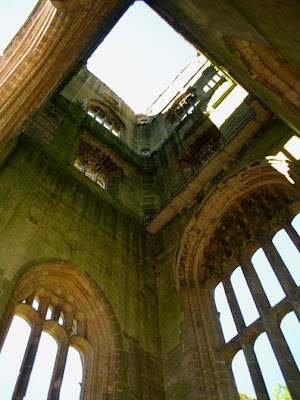We lucked out with the weather again and had beautiful blue skies that only clouded up when we were ready to leave. This time we decided to pack a lunch and eat at the abbey since most of the British use these sites as picnic areas.

Fountains Abbey was founded in 1132 and is another one of Henry the VIII's dissolution victims. Most of the abbeys seem to have gone through multiple stages of decoration/architectural changes as they grew in wealth and the ideals changed. What started off as simple buildings became more ostentatious as the monks decided showing off was a good thing. That's most evident here at the massive bell tower that was added by such an abbot. It is really incredible to stand inside of it and look up. You can look all the way up, since it has no floors, and see the little doorways off of the spiral staircases the monks used for access.

Other than that, some massive stain glass windows (no longer there), and a few other touches, the nave seemed to have retained the austere massiveness of its Norman origins. After seeing Rievaulx, it seemed heavy and plain.

I thought the outbuildings were the most interesting here. I was surprised to see some of the roofs intact since I think Henry's edict was to make the abbeys and their buildings uninhabitable. We were able to walk inside an intact 2-story building with beautiful arched ceilings and what appeared to be original floor tiles on the second floor.

The cellarium (aka cellar) was immense--we estimated 2/3 of a football field. Like it sounds, that's where the monks stored their food. Pat said he could hear the faint beeping of the monks driving their forklifts around. The roof is completely intact and is supported by beautiful stone arches creating a really beautiful warehouse.

After touring the abbey, we walked over to the Studley Royal water gardens. They were created by a guy who acquired the estate in the 1700s. It was like a canal--taking something that used to be wild and manicuring it until it became a geometric representation of itself. It would have been more impressive back in the day when the man-made waterways weren't choked with muck and nastiness. They had statues elegantly placed, but you weren't allowed to get close enough to appreciate them. There were also several little buildings (maybe they call these "follies") where you could imagine rich people hanging out.

Our next stop was for a pot of tea and a scone. Yes, like you might imagine, you can find it everywhere.

On our way home, we stopped at Aldborough Roman Site. They have a few pieces of a fortification wall visible and two shacks in a cow pasture where you can see a Roman villa's floor mosaics where they were found. There is also a small museum with artifacts. After seeing Pompeii, it was a joke. The most interesting thing about it to me was that there was obviously wealth up here. I always thought of England as the wild outskirts of the Roman empire, but there were tons of cities and garrison towns that tried to replicate the comforts of the rest of the empire. Really, they were here for 300 years or so, which seems like a drop in the bucket compared to everything else but is longer than Cincinnati's been in existence.

No comments:
Post a Comment